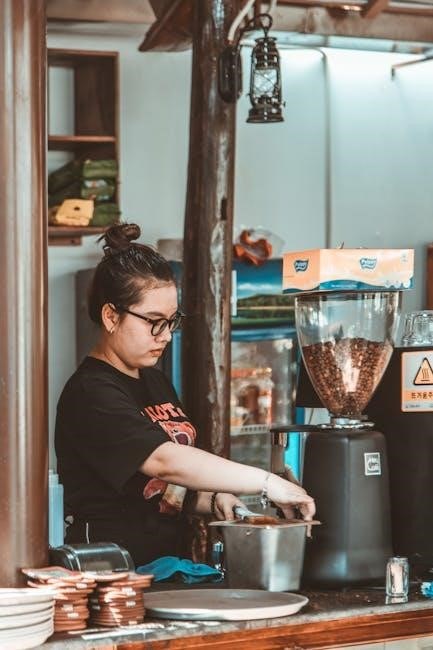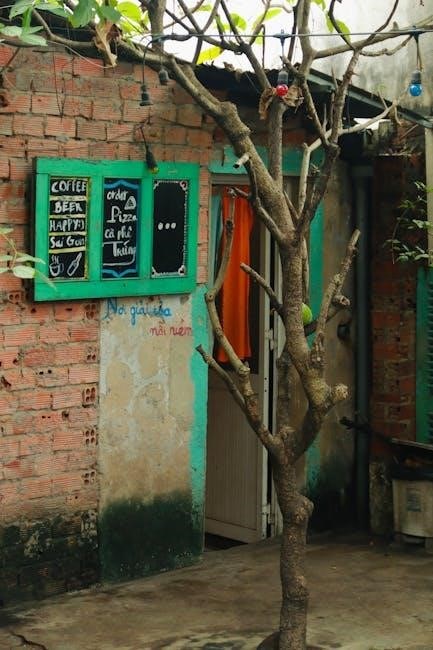
vietnamese coffee guide
Vietnamese coffee is renowned for its rich, bold flavor and aromatic scent, made unique by its traditional brewing method using sweetened condensed milk, creating a distinct and refreshing taste experience that symbolizes the country’s deep-rooted coffee culture and hospitality.
Types of Vietnamese Coffee
Vietnamese coffee offers several unique varieties, including Ca Phe Trung (egg coffee), Vietnamese iced coffee, and Vietnamese salt coffee, each featuring distinct flavors and textures that highlight the diversity of this beloved beverage.
Traditional and Modern Variations
Traditional Vietnamese coffee is deeply rooted in cultural practices, often featuring simple yet flavorful preparations like Ca Phe Den (black coffee) and Ca Phe Sua Da (coffee with condensed milk). These variations emphasize the richness of locally-grown coffee beans and the slow drip brewing method, which creates a robust and aromatic cup.
Modern variations, however, have introduced innovative twists while maintaining the essence of Vietnamese coffee. For instance, the addition of unique ingredients like salt or coconut milk offers a fresh take on classic recipes. Additionally, contemporary baristas are experimenting with cold brew techniques and artistic presentations, making Vietnamese coffee more versatile and appealing to global tastes.
Despite these modern innovations, the traditional methods remain a cornerstone of Vietnamese coffee culture, cherished for their simplicity and authenticity. The balance between honoring centuries-old traditions and embracing creative experimentation ensures that Vietnamese coffee continues to evolve while staying true to its heritage.

How Vietnamese Coffee is Brewed
Vietnamese coffee is traditionally brewed using a small metal filter called a phin, which sits on top of a cup. The process involves slowly dripping rich, bold coffee through the filter into sweetened condensed milk, served over ice.
The Brewing Process
The brewing process for Vietnamese coffee is a meticulous and delightful ritual that combines simplicity with precision. It begins with the preparation of sweetened condensed milk, which is poured into the base of a glass. A small metal filter, known as a phin, is then placed on top of the glass. Medium-coarse ground coffee beans, typically from robusta or arabica varieties, are added to the filter. Hot water is poured over the grounds, allowing the coffee to bloom before the filter is gently pressed down. The coffee slowly drips through the filter into the condensed milk, creating a layered effect. Once brewed, the mixture is stirred well, and the coffee is served over ice for a refreshing finish. This method ensures a bold, rich flavor with a creamy texture from the condensed milk, making it a unique and cherished experience.
The process is both meditative and flavorful, reflecting the cultural appreciation for coffee in Vietnam. The slow dripping of the coffee through the phin allows for a deep extraction of flavors, resulting in a robust and aromatic beverage that is distinctly Vietnamese.

Cultural Significance in Vietnam
Vietnamese coffee holds a profound cultural significance, deeply rooted in the country’s history and daily life. It is more than just a beverage; it is a symbol of hospitality, social connection, and tradition. Coffee shops serve as vibrant hubs where locals gather to share stories, conduct business, and enjoy moments of relaxation. The ritual of sipping Vietnamese coffee is often slow and deliberate, reflecting the nation’s appreciation for mindfulness and community.
From bustling street stalls to charming cafes, coffee culture in Vietnam is a fusion of tradition and modernity. The iconic ca phe has become a national pride, with its unique flavors and preparation methods captivating both locals and visitors. Whether it’s the rich aroma of ca phe phin or the creamy texture of ca phe trung (egg coffee), each cup tells a story of Vietnam’s heritage and creativity.
Coffee has also played a role in shaping Vietnam’s identity, with its popularity growing alongside the country’s independence and economic development. Today, it remains a cherished part of Vietnamese life, bridging generations and fostering a sense of belonging.

Popular Coffee Spots in Vietnam

Vietnam is home to a vibrant coffee culture, with countless cafes and street stalls offering unique coffee experiences. In Hanoi, Café Pho Co and Café Dinh are must-visit spots, known for their iconic egg coffee and charming ambiance. Meanwhile, Ho Chi Minh City boasts Café Sữa Đá and L’Usine, where visitors can enjoy authentic Vietnamese coffee amidst modern and chic settings.
Da Nang is famous for its “coffee kingdom,” a sprawling complex dedicated entirely to coffee, offering everything from traditional brews to innovative creations. Additionally, smaller towns like Hoi An feature quaint cafes such as The Espresso Station, blending local flavors with international coffee standards. These spots are not just places to drink coffee but also hubs for socializing and immersing oneself in Vietnam’s rich coffee traditions.
From bustling city centers to serene countryside retreats, Vietnam’s coffee spots cater to every taste and preference, making them a highlight of any traveler’s journey through the country.

Pairing Vietnamese Coffee with Food
Vietnamese coffee, with its robust and rich profile, pairs wonderfully with a variety of sweet and savory dishes, enhancing both flavor and experience. Traditionally, it is enjoyed alongside local desserts like coconut rice cakes and sesame balls, whose textures and flavors complement the coffee’s creamy sweetness.
For a classic pairing, try matching Vietnamese coffee with traditional desserts such as bánh flan or chè, where the coffee’s bold notes balance the sweetness of these treats. Additionally, the creamy texture of Vietnamese coffee, especially when served with condensed milk, pairs nicely with crunchy snacks like roasted chestnuts or fried doughnuts, offering a delightful contrast of textures.
Exploring these pairings allows one to fully appreciate the depth of Vietnamese coffee and its integral role in the country’s culinary traditions, making each sip a memorable experience.

Health Considerations
Vietnamese coffee, known for its strong flavor and rich aroma, is a beloved beverage that also comes with certain health considerations. One of the primary concerns is its high caffeine content, which can lead to issues such as insomnia, increased heart rate, and anxiety, particularly when consumed in excess. Additionally, the sweetened condensed milk commonly used in Vietnamese coffee adds a substantial amount of sugar, contributing to potential health problems like obesity, type 2 diabetes, and tooth decay.
While moderate coffee consumption is associated with benefits like improved alertness and cognitive function, the strength of Vietnamese coffee may exceed moderate levels for some individuals. The calorie content is another consideration, especially for those managing their weight. For healthier options, reducing the amount of sweetened condensed milk or opting for non-dairy alternatives can be beneficial.
Furthermore, pregnant women and those with caffeine sensitivity should monitor their intake to avoid complications. Overall, enjoying Vietnamese coffee in moderation and being mindful of ingredients can help maximize its benefits while minimizing health risks.

Essential Equipment for Brewing
Brewing Vietnamese coffee requires specific equipment to achieve its distinctive flavor and texture. The most essential tool is the Vietnamese coffee press, known as a phin, a small metal filter that sits on top of a cup. This device allows the coffee to drip slowly, creating a strong, rich brew. Medium-grind French Roast coffee is typically used, as it provides the bold flavor Vietnamese coffee is known for. Sweetened condensed milk is another crucial component, adding sweetness and creaminess to the coffee. A glass or ceramic cup is recommended to preserve the flavor and aroma. For iced coffee, a tall glass filled with ice cubes is necessary to serve the coffee over ice. Finally, a spoon or stirrer is used to mix the condensed milk with the coffee. These simple yet essential tools come together to create the authentic Vietnamese coffee experience, making it easy to brew at home or in a café setting.

Modern Innovations in Vietnamese Coffee
Modern innovations in Vietnamese coffee have elevated this traditional beverage to new heights, blending heritage with contemporary trends. One notable advancement is the rise of specialty coffee shops that experiment with unique flavors while maintaining the essence of Vietnamese coffee. Baristas now incorporate innovative brewing techniques, such as siphon and pour-over methods, to create variations like salt coffee and egg coffee, offering diverse taste profiles. The use of plant-based milks, such as coconut and almond milk, caters to health-conscious consumers and those with dietary restrictions. Additionally, digital tools and apps have emerged to guide home brewers in perfecting their Vietnamese coffee, ensuring consistency and quality. These modern twists not only attract younger generations but also preserve the cultural significance of Vietnamese coffee by adapting to changing preferences and lifestyles. As a result, Vietnamese coffee continues to thrive as a dynamic and evolving part of global coffee culture.

